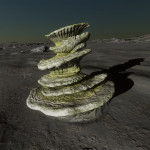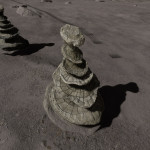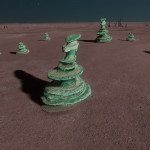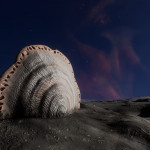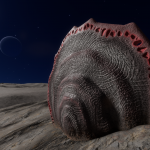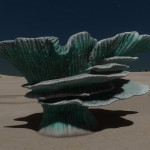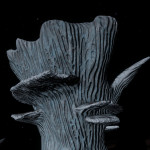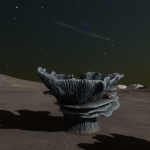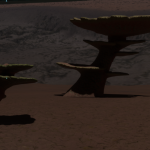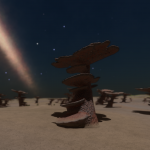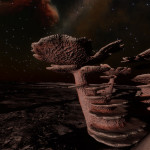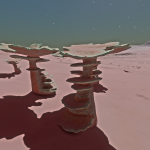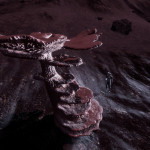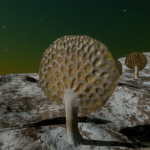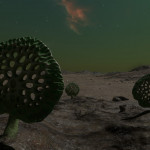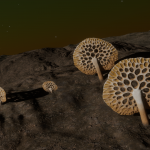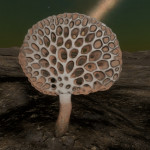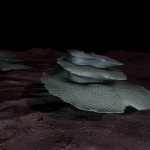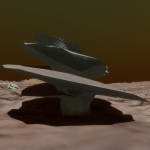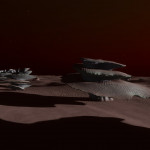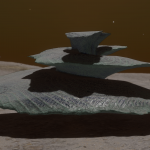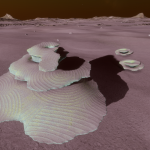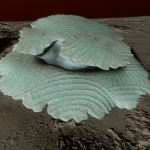Osseus genus
Description
Slow-growing organisms that can be found exclusively on rocky areas of planets. They are defined by a symbiotic relationship that has evolved between two unicellular organisms. which are now inseparable. One cell type is solely responsible for energy production by either photosynthetic. chemosynthetic or thermosynthetic processes. The symbiotic cells harvest some of this energy, and in turn deposit a hard rock-like substance extracted from the local geology to create a rigid endoskeleton. This structure provides a solid base for the organism to exist. It features complex folds that help increase available surface area for metabolic interactions. Osseus have been observed to create callus-like cell coverings, and withdraw themselves into the endoskeleton for protection.
Minimum distance between two genetic samples: 800 m
Conditions of occurrence
- Planets with thin atmosphere
- Only on Rocky, High Metal Content or Rocky Ice (for Osseus pumice) planets
- Only present on rocky areas on planets
- Maximum gravity: 0.27
| Atmosphere type | Species |
|---|---|
| Methane, Methane-rich Argon, Argon-rich Nitrogen | Osseus Pumice |
| Ammonia | Osseus Spiralis |
| Carbon dioxide Carbon dioxide rich | Osseus Cornibus (180 K - 195 K) Osseus Fractus (180 K - 190 K) Osseus Pellebantus (190 K - 195 K) |
| Water, Water-rich | Osseus Discus |
Osseus cornibus
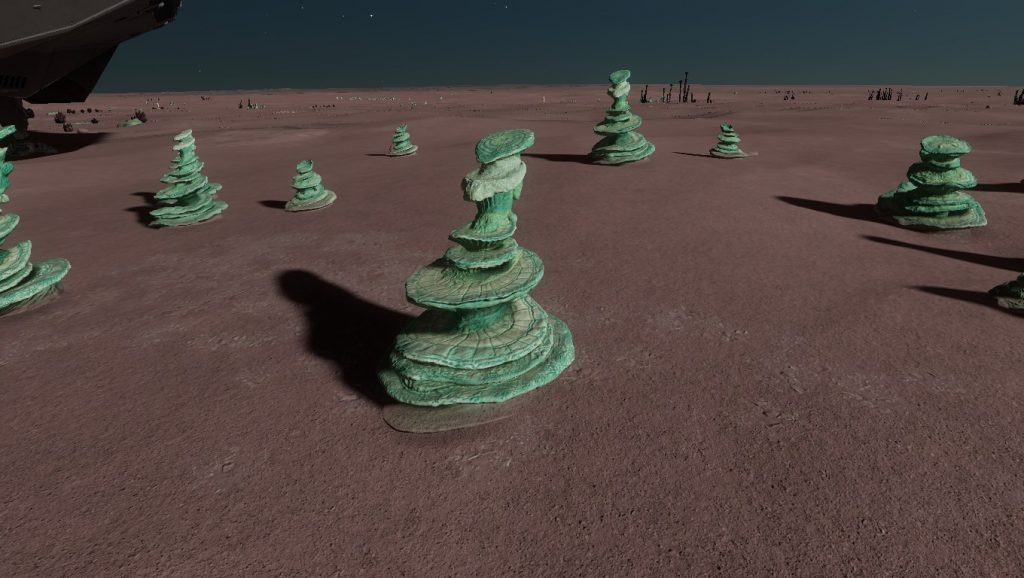
Description
An osseus species that produces a stacked series of spiral structures up to about three metres. These ridged features are upturned to better absorb sunlight for photosynthesis.
Conditions of occurrence
- Planets with thin Carbon dioxide atmosphere
- Only on Rocky or High Metal Content planets
- Only present on rocky areas on planets
- Maximum gravity: 0.27
- Mean temperature between 180 K and 195 K
Colored variants
Colored variant determined by the parent star type
| Star type | Color |
|---|---|
| O | |
| B | |
| A | Lime |
| F | Turquoise |
| G | Grey |
| K | Indigo |
| M | |
| L | |
| T | Emerald |
| TTS | Green |
| Y | |
| W | |
| D | |
| N |
Osseus discus
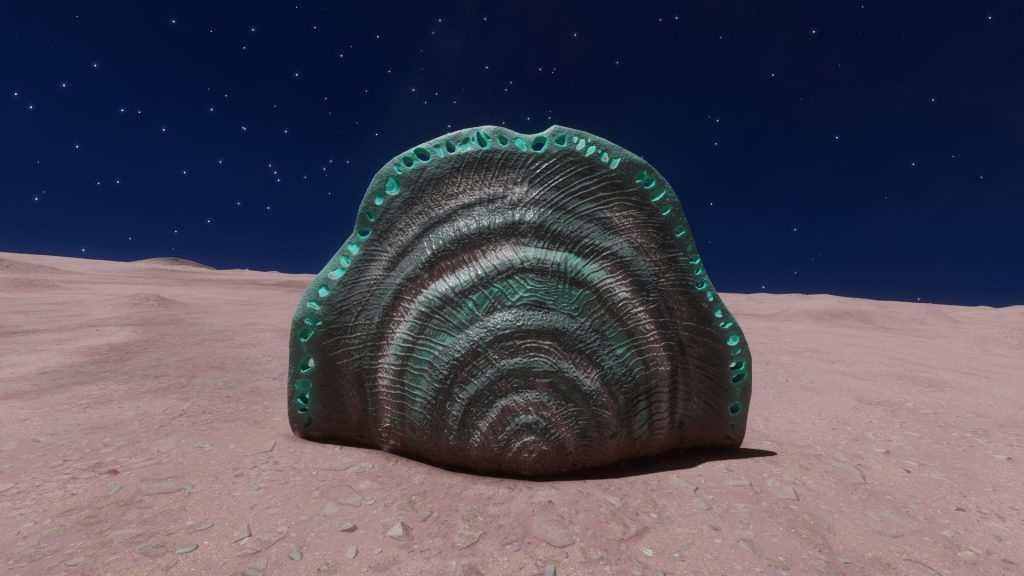
Description
An osseus that appears as half-buried discs with radial patterns, which may resemble natural rook formations from a distance. They absorb geothermal energy from below the surface as well as available heat sources above ground.
Conditions of occurrence
- Planets with thin Water atmosphere
- Only on Rocky or High Metal Content planets
- Only present on rocky areas on planets
- Maximum gravity: 0.27
Colored variants
Colored variant determined by rare material found on planet:
| Material | Color |
|---|---|
| Cadmium | White |
| Mercury | Lime |
| Molybdenum | Peach |
| Niobium | Aquamarine |
| Tungsten | Red |
| Tin | Blue |
Osseus fractus

Description
This osseus species can grow to over six metres across. They produce wide ridged frills for metabolic interactions including aosorbing sunlight for energy production.
Conditions of occurrence
- Planets with thin Carbon dioxide atmosphere
- Only on Rocky or High Metal Content planets
- Only present on rocky areas on planets
- Maximum gravity: 0.27
- Mean temperature between 180 K and 195 K
Colored variants
Colored variant determined by the parent star type
| Star type | Color |
|---|---|
| O | |
| B | |
| A | Lime |
| F | Turquoise |
| G | Grey |
| K | Indigo |
| M | |
| L | |
| T | Emerald |
| TTS | Green |
| Y | |
| W | |
| D | |
| N |
Osseus pellebantus
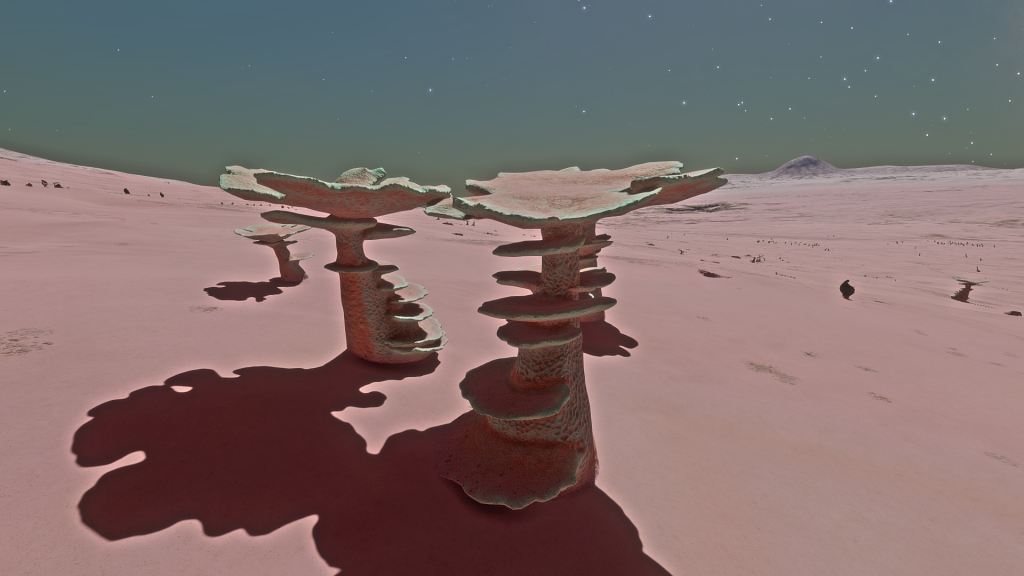
Description
A species of osseus with a single broad stalk from which extend wide circular structures, with the largest plate capping the top to maximise sunlight absorption.
Conditions of occurrence
- Planets with thin Carbon dioxide atmosphere
- Only on Rocky or High Metal Content planets
- Only present on rocky areas on planets
- Maximum gravity: 0.27
- Mean temperature between 180 K and 195 K
Colored variants
Colored variant determined by the parent star type
| Star type | Color |
|---|---|
| O | |
| B | |
| A | Lime |
| F | Turquoise |
| G | Grey |
| K | Indigo |
| M | |
| L | |
| T | Emerald |
| TTS | Green |
| Y | |
| W | |
| D | |
| N |
Osseus pumice

Description
This osseus species grows a single thick stalk from which emerges a wide, broadly circular, pitted endoskeleton. This structure is designed to dramatically increase the surface area to volume ofthe organism, facilitating chemical capture and chemosynthesis on its catalytically active surface.
Conditions of occurrence
- Planets with thin Argon, Methane or Nitrogen atmosphere
- Only on Rocky, High Metal Content or Rocky Ice planets
- Only present on rocky areas on planets
- Maximum gravity: 0.27
Colored variants
Colored variant determined by rare material found on planet:
| Material | Color |
|---|---|
| Antinomy | White |
| Polonium | Peach |
| Ruthenium | Gold |
| Technetium | Lime |
| Tellurium | Green |
| Yttrium | Yellow |
Osseus spiralis

Description
A species of osseus that produces coiling spiral structures up to six metres wide. There are ridged folds on their upturned surfaces designed to capture sunlight.
Conditions of occurrence
- Planets with thin Ammonia atmosphere
- Only on Rocky or High Metal Content planets
- Only present on rocky areas on planets
- Maximum gravity: 0.27
Colored variants
Colored variant determined by the parent star type
| Star type | Color |
|---|---|
| O | |
| B | |
| A | Lime |
| F | Turquoise |
| G | Grey |
| K | Indigo |
| M | |
| L | |
| T | Emerald |
| TTS | Green |
| Y | |
| W | |
| D | |
| N |
